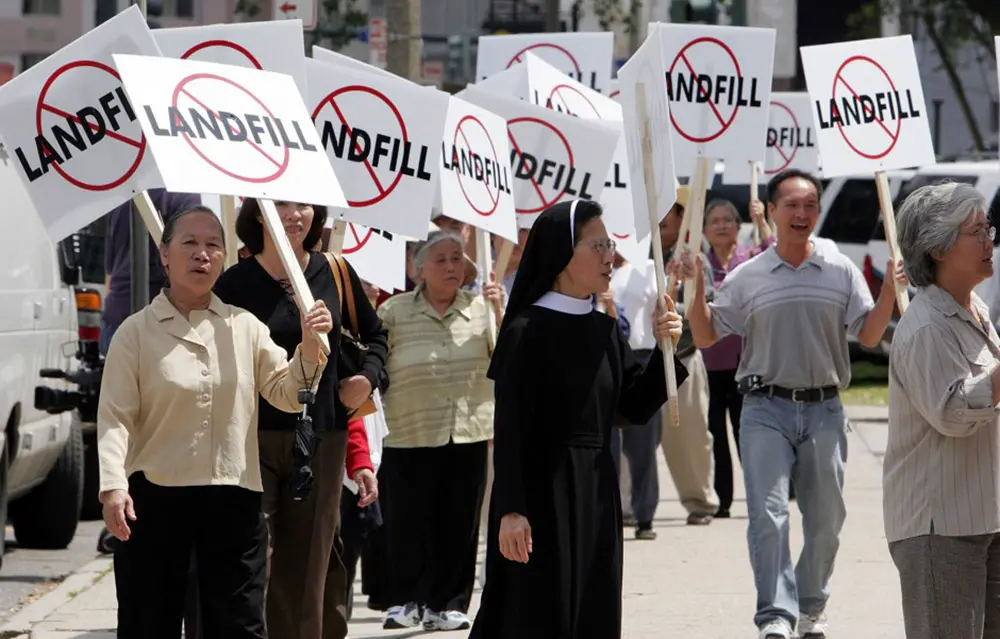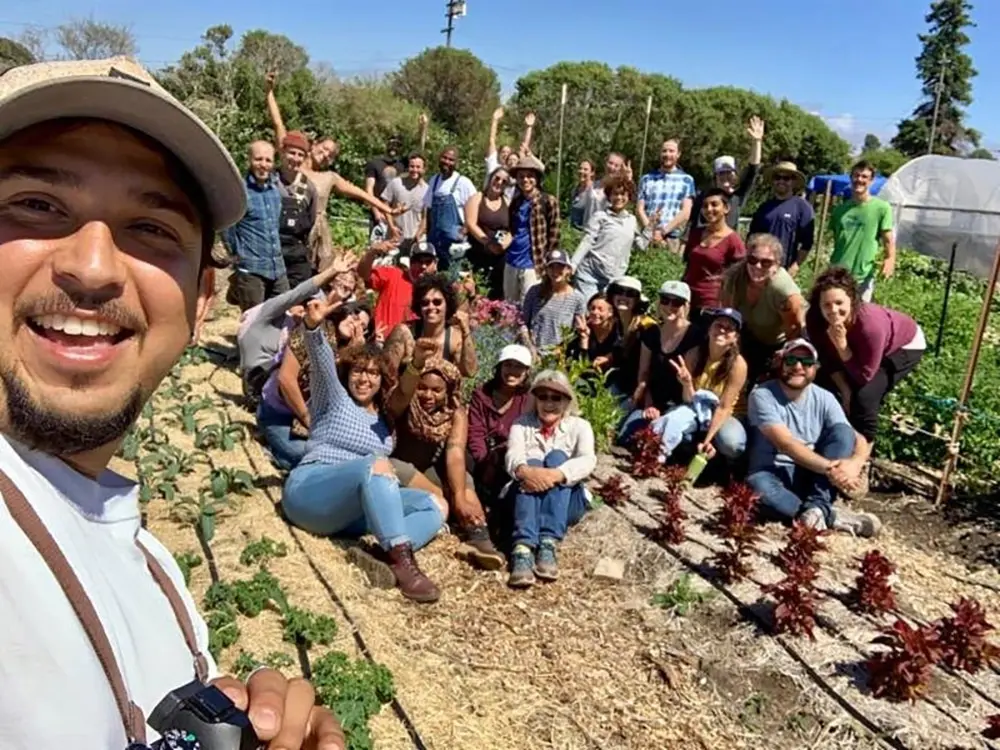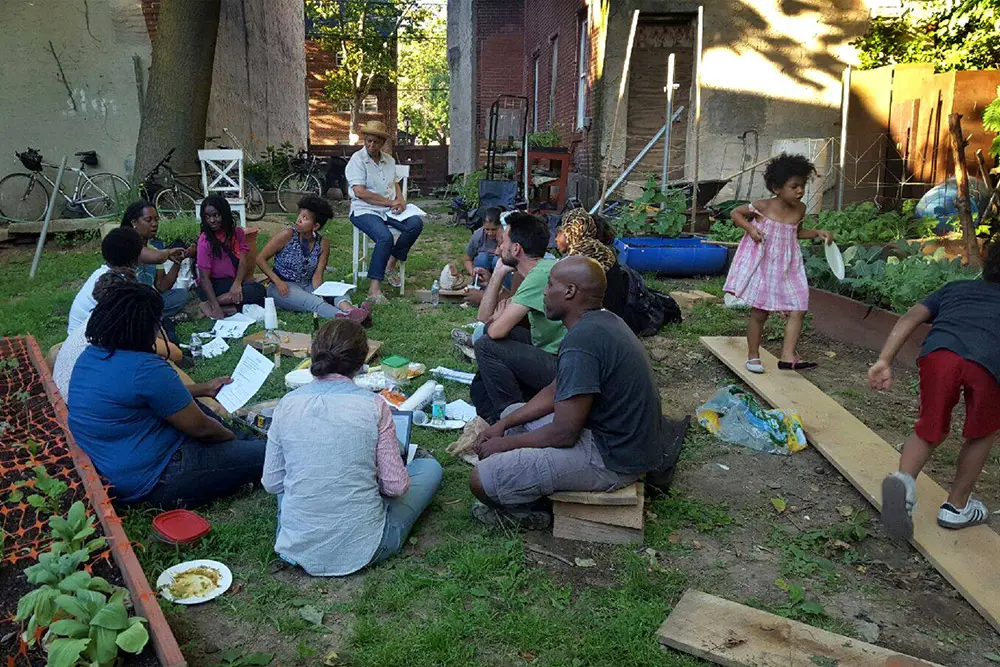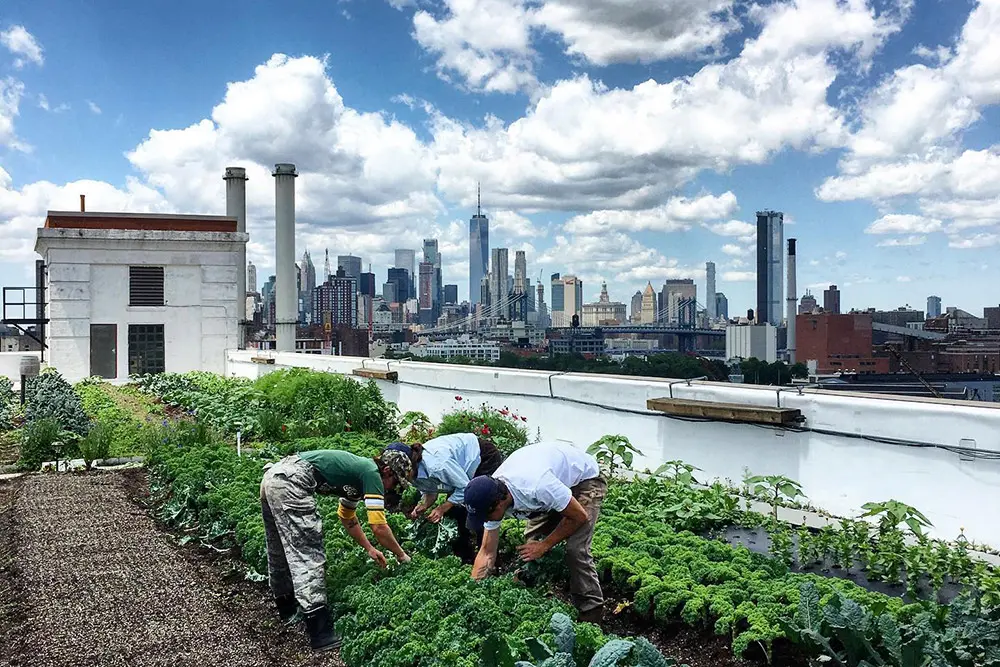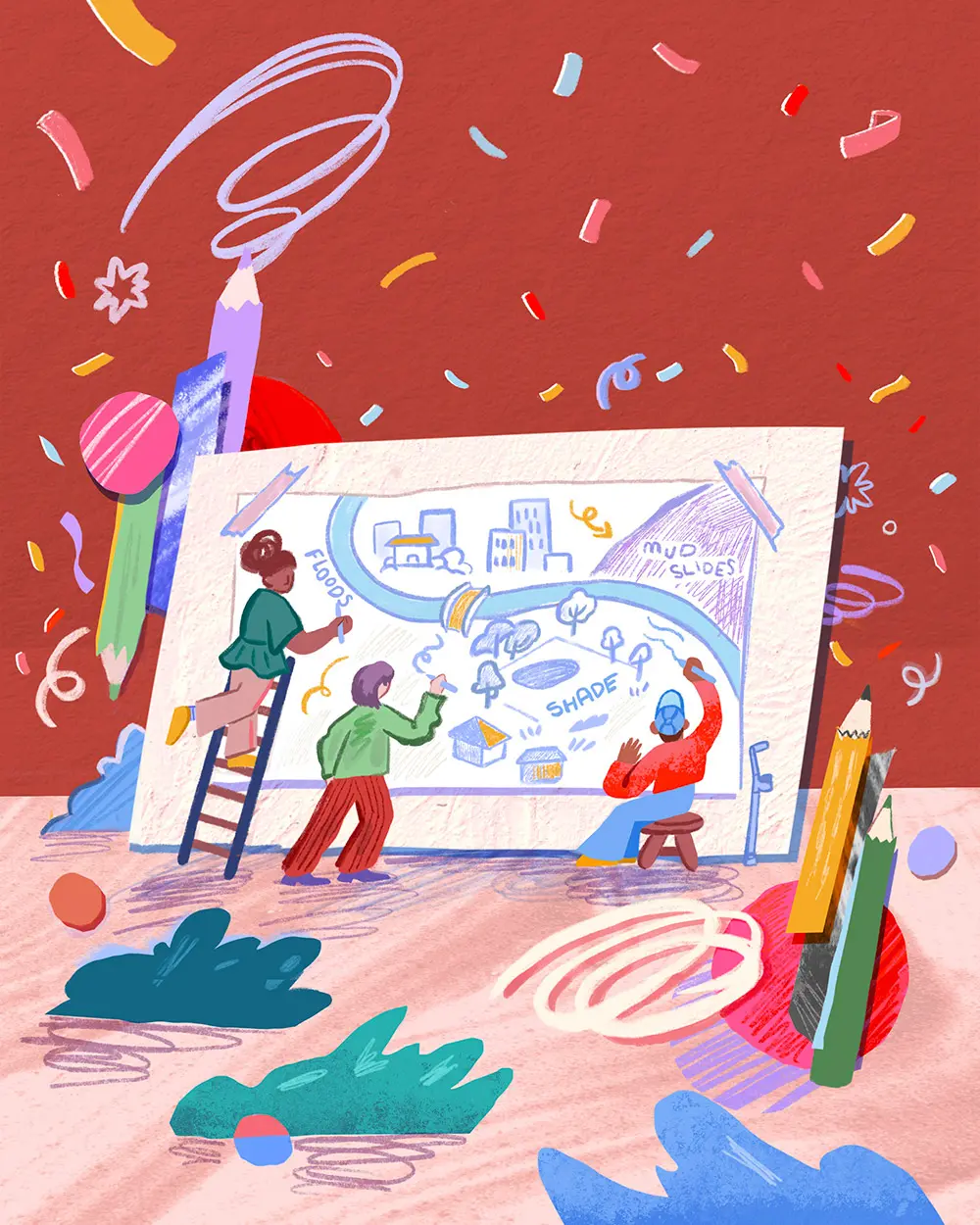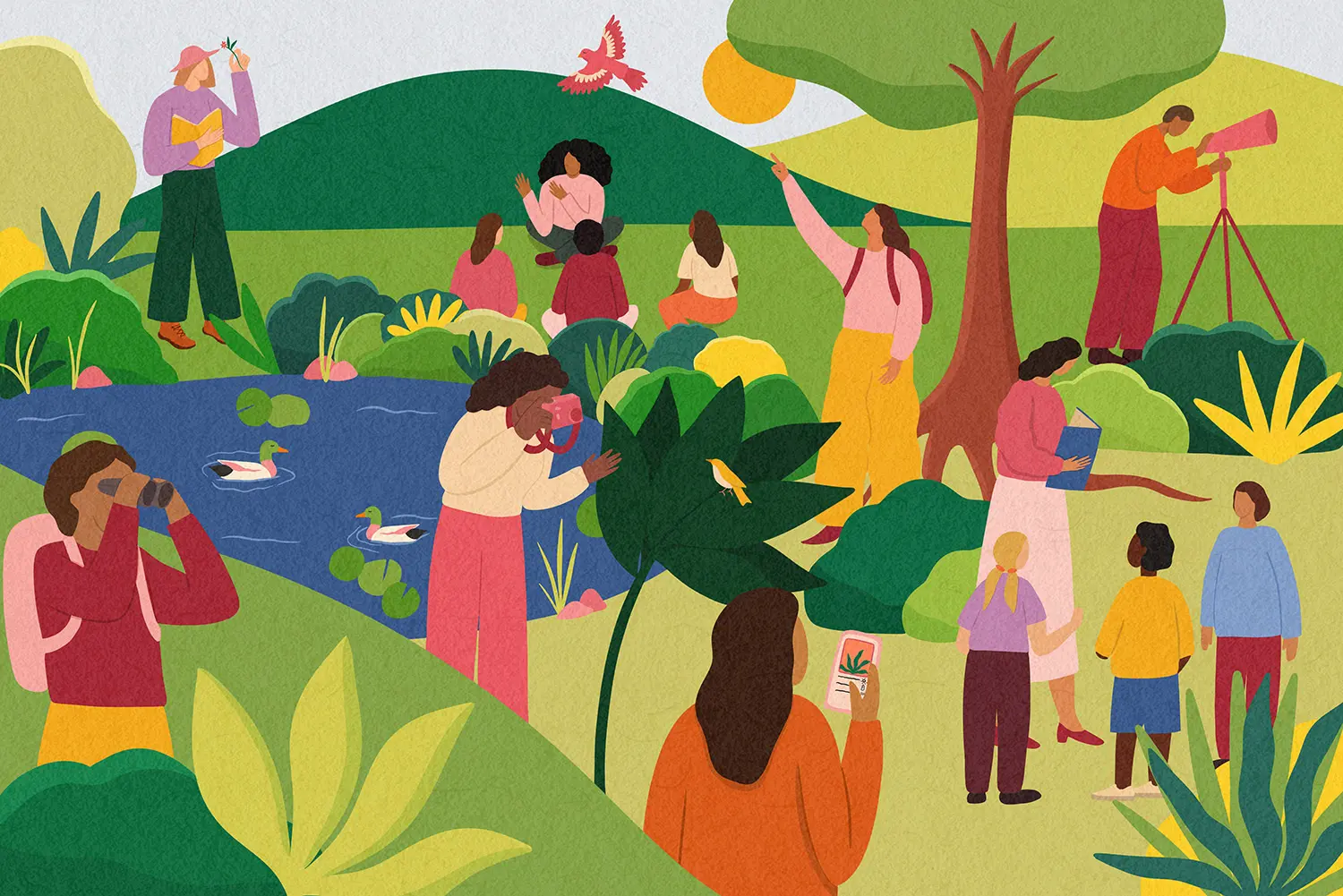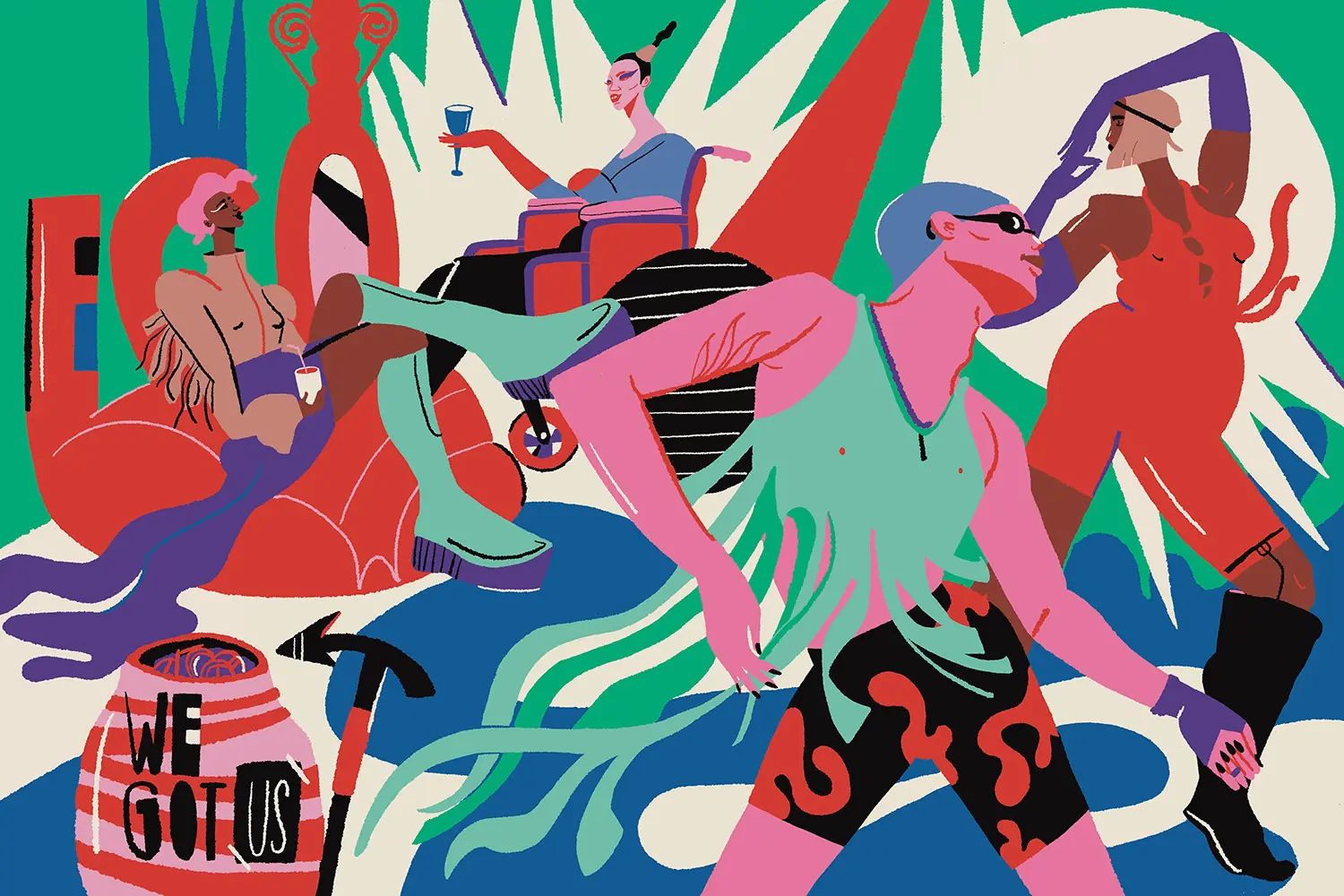Climate resilience as Urban Farming
Urban Farming is a powerful tool to:
- Decentralize the food system and buffer urban residents from disruptions in food system supply chains
- Boost accessibility of nourishing, delicious, and culturally preferred foods for all
- Introduce more green space into cities
- Cultivate community and connection
- Improve ecoliteracy and food system understanding
- Create good jobs

What it is: The urban agriculture tapestry is diverse and bountiful, from community orchards to vertical farms, plot-based community gardens to backyard chicken coops, rooftop beehives to aquaponics greenhouses. Urban farming projects range widely in what they prioritize and optimize for, from food production, good jobs, and education to community events and ecological benefits. There is no singular urban farming playbook, and so there’s tremendous freedom to figure out what makes the most sense for every community.
Some additional context: Urban agriculture has existed as long as cities have existed, though there are a handful of moments in urban agriculture history that are particularly well-known; during World War II, in a government-driven push for solidarity with soldiers on the warfront, close to 20 million families planted seven million acres of victory gardens across the United States, in their yards, city hall lawns, and public parks, producing about 40% of the vegetables consumed nationally. In the aftermath of the Soviet Union’s collapse, as Cuba experienced a major economic crisis and was cut off from trade with the rest of the world, Cubans looked to ancestral farming traditions to transform their food system, growing food in pots on decks, containers on rooftops, and slices of vacant land in town and cities. Today, a robust patchwork of 86,000 acres of land comprises the impressive urban agriculture landscape of Havana. And in post-industrial Detroit, Michigan, the city’s so-called Renaissance is characterized in part by the proliferation of gardens and farms sprouting up across the city’s estimated 100,000 vacant lots. The city isn’t new to urban agriculture, and in fact urban farming was popularized in Detroit as early as 1893, when the mayor urged starving residents to get through the economic crisis by growing potatoes in their yards and on the city’s public land. Urban agriculture has been a lifeline for countless communities, particularly during moments of crisis.
Continue readingWhy it’s a climate resilience powerhouse:
Decentralizing the food system and buffering urban residents from disruptions in food system supply chains
As extreme weather intensifies and becomes more frequent, therefore impacting the production, processing, and transportation of food, growing food close to home can help to ensure that people are fed no matter what. Currently, just a handful of corporations control the vast majority of the food supply chain in the United States. More than half of fruit and about a third of vegetables consumed in the United States are imported. Since the food system is so concentrated and food supply chains are often thousands of miles long, a small breakdown, whether a power outage, crop loss, or highway closure, can rapidly wreak havoc on the entire system. The more that food systems can decentralize and the closer that food can be grown to home (or, more specifically, in cities, where an estimated 83% of the American population resides), the better prepared our food systems will be to endure unpredictability and climate chaos.
Continue readingBoosting accessibility of nourishing, delicious, and culturally preferred foods for all
Homegrown food picked at peak ripeness is generally tastier, more nutrient-dense, and far more affordable than produce shipped from thousands of miles away. Urban agriculture projects by and for the local community also often grow culturally preferred foods (or foods that people are familiar with eating and/or cooking, foods that taste like home, foods that are grown or prepared in accordance with customs and values, etc.) that may not be available at nearby markets. Urban agriculture projects can be an important piece of a larger strategy to ensure that all community members are truly nourished in body and soul.
Introducing more green space into cities
Urban farms and gardens have ecological benefits that will only become more advantageous as weather grows more extreme, from absorbing rainwater and filtering air pollution to mitigating heat and providing habitat for birds, insects, and other biodiversity. Rooftop gardens help to insulate buildings from extreme cold and heat and therefore lower energy demand (for instance, researchers have found that the green roof atop Chicago City Hall measures almost 80°F cooler than neighboring conventional rooftops on a typical day). Urban agriculture projects, particularly those that transform vacant lots and break up concrete landscapes with vibrant green space, are also linked to mental and physical health benefits, like reducing acute stress levels and boosting overall wellbeing for people walking by or visiting.
Continue readingCultivating community and connection
Community-based urban agriculture projects, like plot-based community gardens or homegrown-food-sharing programs (like LA Fruit Share), facilitate organic, consistent, and generally positive interaction amongst neighbors. The more opportunities that people have to get to know and build trust amongst fellow community members (and the land that sustains them), the better positioned they will be to support one another through climate-related crises.
If you grow together, you grow together. Ron Finley, Guerilla gardening advocate (source)
Improving ecoliteracy and food system understanding
Improving ecoliteracy and food system understanding: Many urban agriculture projects have an education component, and even for those that don’t, the process of growing food imparts wisdom and appreciation for food systems and the value of food, biodiversity, weather patterns (and irregularities), ecological principles and processes, interdependence, reciprocity, dynamic balance, and more. There was a time when most folks grew up with some level of hands-on interaction with food systems; after all, at the turn of the twentieth century, about 40% of Americans lived on farms. Now, just 2% do. Urban agriculture projects give folks who live in cities (again, where an estimated 83% of the American population resides), far removed from most “farmland,” to engage in the extraordinary, empowering act of growing food, to strengthen their relationship with the land, water, and more-than-human beings around them, and to gain the skills needed to grow food in a pinch if they ever need to- just add seeds, sun, and water!
Continue readingSpend a few months taking a broccoli from seed to harvest, and you’ll soon have a much deeper appreciation for the natural systems on which we depend. Our connection to the earth becomes gobsmackingly obvious when you watch the crops grow (or fail). The garden produces a harvest of teachable moments about what it means to live in an environment. Jason Mark, Writer-farmer (source)
Creating good jobs
Many urban agriculture projects prioritize community-led economic development, workforce training, and the creation of dignified, empowering, and living-wage jobs, particularly for those most excluded from the job market.
The nuance / caveats:
Despite its countless benefits, urban agriculture is not a panacea. City gardens and farms have repeatedly been linked with gentrification and displacement, particularly when the efforts are led by community outsiders or co-opted by developers. The urban farming ventures that receive the most funding often do the least to challenge the root of exploitative food systems and food injustices. Growing enough food to meaningfully feed city residents requires vast amounts of space, which cities rarely have in abundance, and many argue that land would be better utilized for housing rather than instigating further sprawl. Lots of urban farmers themselves lament that the benefits of urban agriculture are overhyped and oversold. Zoning and public nuisance laws often criminalize or complicate the growing of food. And, while growing food can be an act of self-determination, liberation, and resistance, many communities, particularly the African diaspora, have experienced a history of exploitation and enslavement for agricultural labor. Growing food in cities is powerful and it is also complex. It’s just one tool, and it should be approached with nuance and care.
Continue readingSpotlights

Detroit Black Farmer Land Fund is a coalition of Detroit urban farming organizations, including the Detroit Black Community Food Security Network (DBCFSN), Oakland Avenue Urban Farm, and Keep Growing Detroit, dedicated to rebuilding intergenerational land ownership for Black farmers in Detroit. Detroit has a robust and growing tapestry of urban farms and community gardens, and while a large portion are run by Black farmers, relatively few land-based projects are owned by Black farmers. The Detroit Black Farmer Land Fund is working to change that. They provide monetary awards directly to farmers to buy land from the Detroit Land Bank Authority and they’ve also begun offering financial support to purchase infrastructure and equipment.
You can support the Detroit Black Farmer Land Fund by making a financial donation or donating gently used equipment or land in the Detroit area.
Continue reading about Urban Farming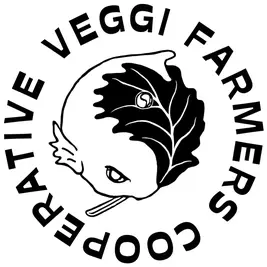
Village de l’Est Green Growers Initiative (VEGGI) Farmers Cooperative is a community member-owned and operated cooperative of farmers and fisherfolk based in Village de L’Est, a Vietnamese-American neighborhood in New Orleans. The cooperative emerged to create good, sustainable jobs after the BP oil spill, which decimated the shrimping industry and cost many Village de L’Est community members their jobs and/or subsistence. VEGGI members grow Vietnamese heirloom veggies and herbs, along with other food and flowers, on a two-acre farm and in backyard gardens, neighborhood greenhouses, and aquaponic growing systems. During the pandemic, VEGGI partnered with VAYLA New Orleans during the pandemic to deliver fresh, culturally preferred grocery staples, voter registration materials, and in-language hurricane preparedness guidance to hundreds of nearby families who would not otherwise receive aid.
You can support VEGGI by signing up for their CSA Program.
Continue reading about Urban Farming
Urban Tilth is a nonprofit working to build a more sustainable, nourishing, and just food system in Richmond. Thus far, they’ve created seven school and community gardens and urban farms upon which they grow tens of thousands of pounds of food, teach and train youth, employ young people and local residents, build community, organize around pressing community justice issues, and more. Urban Tilth’s community leadership extends far beyond their urban agriculture projects, too; they provide fiscal sponsorships and support to several goals-aligned projects, like Cooperation Richmond, the Richmond Grows Seed Lending Library, and the Richmond Our Power Coalition, and they’re active members of the Climate Justice Alliance and US Food Sovereignty Alliance.
You can support Urban Tilth by signing up for their CSA, joining a community volunteer day, or making a monetary or stock donation,
Continue reading about Urban Farming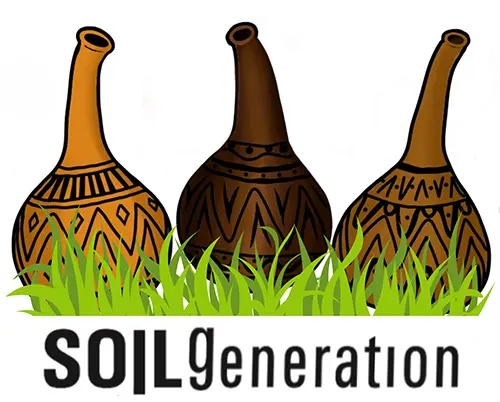
Soil Generation is a coalition of Black and Brown women and non-binary farmers and organizers working towards food sovereignty and land justice in Philadelphia through relationship building, community education, organizing, activism, and advocacy. They’ve worked hard to protect community gardens and farms, amend city policies and zoning codes, organize and educate folks to start new urban agriculture projects on vacant city land, uplift Philadelphia’s rich urban agriculture history, and more. In 2019, following years of effective political organizing, Philadelphia Parks and Recreation tasked Soil Generation with co-creating the city’s first ever Urban Agriculture Strategic Plan.
You can support Soil Generation by making a donation or engaging with their ongoing campaigns and community projects.
Continue reading about Urban Farming
Brooklyn Grange is the country’s leading rooftop farming and intensive greef roofing business. They’ve built three rooftop farms in Brooklyn and Queens that collectively produce over 100,000 pounds of organically-grown vegetables each year, and about a third of their produce is distributed to community members at no cost through community-based organization partners. Brooklyn Grange is a social enterprise, not a nonprofit, and they’ve figured out how to sustain their community-focused programs, like youth education (they’ve brought over 40,000 youth to their farms for educational excursions and workshops thus far!), by hosting amazing events and offering urban landscaping and consulting services- they’ve helped to actualize green roofs, urban farms, restaurant gardens, green walls, and more all over New York City!
You can support Brooklyn Grange by signing up for their sliding scale CSA or attending a workshop or community event.
Continue reading about Urban FarmingResearch + reflection prompts:
- If you’re a city dweller, what urban farms already exist or are emerging in your area? Which efforts are community-driven and committed to advancing liberation and justice?
- Which organizers are working hard to advance the urban agriculture movement in your community?
- If nearby grocery stores couldn’t stock produce for weeks or months, where might you be able to find basic necessities elsewhere in your community?
- If you can’t find any urban agriculture projects in your area, might zoning restrictions, public nuisance laws, or other restrictive policies be a factor?
- Imagine if city streets, parking spaces, and vacant lots were transformed into gardens and farms. What would that look like, feel like, smell like, taste like?
How to get engaged:
Community-supported agriculture
If you enjoy regularly cooking: Consider joining a values-aligned, community-supported agriculture (CSA) food box program, which is how many urban farms financially sustain their options. CSA boxes are typically delivered on a weekly basis and include a mix of seasonal vegetables and fruits, sometimes with the option to add other delicacies made on the farm. A CSA box subscription is a fantastic way to consistently support urban farmers and ensure that your kitchen is always stocked with delicious produce. Some CSA programs have sliding scale pricing or offer subsidized or no-cost boxes for low-income folks.
Grow Food At Home
If you have access to time and sunlight: Begin growing food at home. Nutrient-dense sprouts and microgreens can be grown on kitchen counters with a sunny window. If you have access to a deck, courtyard, or rooftop that receives several hours of sunshine each day, try growing greens, root vegetables like carrots and radishes, citrus, and herbs in pots, growbags, or reused containers. If you have access to a yard, try growing a kitchen garden in raised beds (or plant food in-ground, but make sure to test your soil first). According to the Old Farmers Almanac, just 200 square feet is needed to grow enough produce to feed an omnivore for a year! That being said, start small, go slow, and share your bounty with friends and neighbors when the harvest is overwhelming.
Community Gardens
If you have access to time and a nearby community garden: Do some research on the community garden that’s the best fit for you and get involved. Would you rather have your own plot to tend on a regular basis, or would you prefer to occasionally join community workdays at a collectively managed garden? If there aren’t any community gardens near you, and you have the passion and bandwidth to take on a major project, consider starting one yourself (ideally with other nearby pals).
Organize with friends
If there are policy-related barriers to urban agriculture in your community: Organize with friends and neighbors to advocate for policy that supports and decriminalizes growing food in cities. Get to know the Right to Farm laws in your state. Look to cities with robust urban agriculture landscapes for policy inspiration. Contact your local representatives and attend city meetings to express why it’s an important issue to you and what specifically you’d like to see change.
Create spaces
If you work in city planning, architecture, development, or design: Create spaces and policies with intention to enable the growing of food on private and publicly owned lands. Partner with organizers and listen to community members to learn more about the barriers that currently exist and better understand the solutions that they’d like to see.
Best Practices
Befriend your local nursery and lean on their team for guidance. Test for soil contaminants like lead, arsenic, and other heavy metals before planting food in-ground. If you have the opportunity, get to know sunlight exposure at different times of the day and the year before selecting a place to plant. Start small and harvest regularly. Remember to add plants that will invite pollinators to your garden. In any efforts beyond your home, follow the lead of and center the community members who are most impacted by food injustices and would be most vulnerable to potential gentrification. Grow food with others.
A smattering of resources for continued learning + action:
Short Reads
Long Reads
- Farming While Black: Soul Fire Farm’s Practical Guide to Liberation on the Land by Leah Penniman
- Rebuilding the Foodshed: How to Create Local, Sustainable, and Secure Food Systems by Philip Ackerman-Leist
- EAT UP: The Inside Scoop on Rooftop Agriculture by Lauren Mandel
- Garden Anywhere by Alys Fowler
- The Good Food Revolution: Growing Healthy Food, People, and Communities by Will Allen
- Freedom Farmers: Agricultural Resistance and the Black Freedom Movement by Monica M. White
- Urban Foraging: Find, Gather, and Cook 50 Wild Plants by Lisa M. Rose
- Urban Farmers: The Now (and How) of Growing Food in the City edited by Valery Rizzo and gestalten
Watch
- Growing Cities: A 2013 documentary film that examines the role of urban farming in America and asks how much power it has to revitalize our cities and change the way we eat
- Land Grab: A 2016 documentary film that follows the story of a finance mogul’s dream to create the world’s largest urban farm in his hometown of Detroit and the political firestorm that ensues
Listen
Engage More Deeply
- If you’re based in or near New York City and are interested in building your urban farming skills and confidence and deepening your understanding of food justice issues and food politics, check out Farm School NYC’s year-long urban agriculture training program
- If you’re looking to level up your small-scale organic farming chops or strengthen your food and farming business, check out these online, self-directed courses through The Market Gardener Institute
- Particularly if you’re involved in a California-based food and farming project, explore some of the comprehensive legal guides created by Sustainable Economies Law Center

